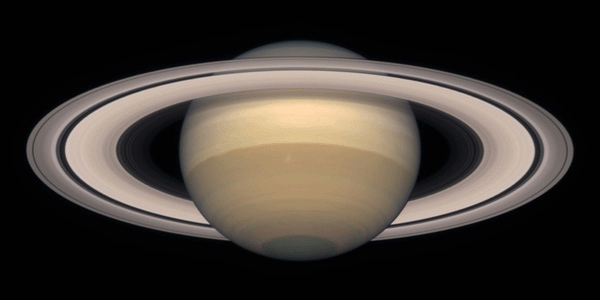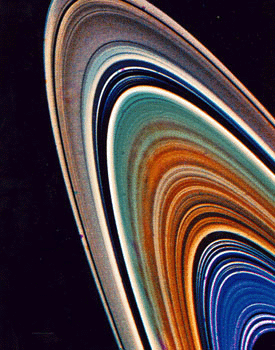Introduction
Saturn is a unique planet because of the disc-shaped ring system surrounding it. Galileo first observed the disc in 1610, but thought that it looked more like two large moons because his telescope was not very powerful. In 1655, another astronomer named Huygens was the first to describe the disc as a ring that surrounded, but did not touch, the planet Saturn. He was followed by Cassini, who in 1675 observed that there was a major division in the ring, now called the Cassini Division. This meant that there were at least two rings surrounding Saturn.

Today we know that Saturn is surrounded by a huge network of rings, called a ring system, each with unique properties. New information from high powered telescopes (like the Hubble Space Telescope) and spacecraft (like Voyager 1 and 2) have added to our understanding of the rings. The most recent spacecraft sent to Saturn was named Casini-Huygens in honor of the first astronomers to study the ring system of Saturn. This mission consists of the Cassini spacecraft which is orbiting the planet, and the Huygens probe, which landed on Saturn's largest moon, Titan.
Modern images of the rings of Saturn have helped astronomers understand how unique the individual rings are. Saturn has seven major rings, and each major ring is made up of many minor rings. The rings differ from each other in composition (what each ring is made of), rotational speed (how fast the particles of the ring orbit the planet) and appearance (what each ring looks like to an observer).

What are the rings of Saturn made of? Why do they look like rings? What makes each ring look unique from other rings? In this experiment, you can investigate how the composition of a ring can change its appearance.
Terms and Concepts
To do this type of experiment you should know what the following terms mean. Have an adult help you search the internet, or take you to your local library to find out more!- planets
- Saturn
- rings
- orbit
- What are Saturn's rings made of?
- How can individual particles create the appearance of a ring?
- How do the properties of each ring make it unique?
Materials and Equipment
- several sheets of black construction paper
- glue
- different types of small particles of different size, shape and color:
- sand,
- salt,
- glitter,
- rice,
- beans, etc...
- an old record player (make sure you ask first!)
- an old record
- camera
Experimental Procedure
- Select one piece of construction paper for each type of material you will be testing.
- Trace the outer edge and the center hole of the record on each sheet of paper.
- Cut out the outside of the record shape and poke a hole in the center with a pencil.
- Glue the pieces of material to the outer edges of the circle, using a separate circle for each material. The pieces do not need to be tightly packed or uniformly arranged. Think about how pieces of rock and dust might be randomly distributed in the rings of Saturn.
- Repeat step four for each type of material and allow all of the circles to dry thoroughly.
- After the circles are dry, place your first circle on the record player.
- Using a camera, take an overhead picture of the circle while it is still.
- Now turn on the record player and take another overhead picture of the circle while it is moving.
- Repeat steps 7 and 8 for each type of material.
- Print or develop your pictures. Label each picture with the type of material and with "Before" or "After" to keep them organized. You will want to use your pictures for your poster too.
- For each material note the appearance before and after rotation, noting the resulting color and appearance of the material.
- How do the materials become a ring-like structure? Are some materials different looking than others? How do different types of materials make each ring unique? How do the size and shape of each material change the appearance of the ring?
No comments:
Post a Comment